Are you currently living a plant-free life? Do you think you’ve got a brown thumb? Whether you travel a lot, your home is dark, or you’re just forgetful when it comes to watering, there are plants that thrive on inattention.
Plants measurably improve our indoor environment. They convert carbon dioxide into oxygen, remove toxins from the air, decrease stress, and improve concentration and mood. Plus, they’re nice to look at!
The following plants are the ultimate “set it and forget it” vegetation. Don’t worry about showing them your love through water; these plants crave negligence.
The Snake Plant
Sansevieria Trifasciata
Snake plants can be grouped into one of two basic shapes: tall and upright, and the more compact “bird’s nest” varieties (which stay closer to their pots). Both types feature stiff, spear-like leaves with sharp edges.
When it comes to caring for your snake plant, just remember the rules from the movie “The Gremlins”: One, they don’t like direct sun. Two, they don’t like too much water. And lastly, don’t feed them after midnight. (Just kidding about that third one!)
Snake plants like bright indirect light (but they tolerate low light) and they only need to be watered about every three weeks (let the soil dry between the watering).
ZZ Plant
Zamioculcas Zamiifolia
Slow and steady wins the race for the tough, hardy ZZ plant. It’s sometimes called “the eternity plant” because like Dracula, it seems immortal and unchanging. The first time you see one, you might think its thick, durable leafstalks are made of plastic…but it’s actually a potent air purifier. It can go four months without water under low, interior light. It also grows very slowly, so buy the size your heart desires! It’ll be happy under almost any lighting conditions, but don’t put it in direct sunlight. Also, don’t overwater!
Cast Iron Plant
Aspidistra Elatior
Talk about a plant that lives up to its name. The Cast Iron plant is tolerant of low light, low humidity, extreme pollution and dust, and irregular watering. It can withstand a wide range of temperatures (23-100°F), and doesn’t get mad if you insult its mother. If you add its lush leaves to a floral arrangement, they’ll last for weeks. The plant is native to Taiwan and southern Japan, but was introduced to England in 1822, where it quickly became extremely popular in coal-heated and gas-lit Victorian households (talk about dim and dirty!).
Goldfish Plant
Nematanthus Gregarius, Nematanthus Wettsteinii, Nematanthus Glabra
If you crave color, check out the goldfish plant. There are 30 different species of Nematanthus (nicknamed because the fused petals of its flowers look like leaping goldfish).
In young plants, the stems grow upward, but they trail as the plant matures, making this an excellent choice for a hanging basket. Relatively hardy, Nematanthus can tolerate drought and temperatures as low as 40°F — but for profuse flower production, give it humidity, normal home temperatures, and lots of indirect sunlight (like an east-facing window).
Your goldfish plant should live for a decade… but if you do accidentally kill it, please don’t flush it down the toilet.
Good luck and happy gardening!







